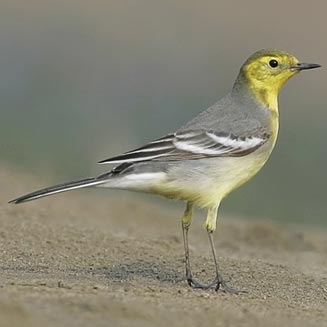|
Motacilla citreola (Citrine
wagtail)
Sitrienkwikkie [Afrikaans]; citroenkwikstaart citrine
[Dutch]; Bergeronnette citrine [French]; Zitronenstelze [German]
Life
> Eukaryotes >
Opisthokonta
> Metazoa (animals) >
Bilateria >
Deuterostomia > Chordata >
Craniata > Vertebrata (vertebrates) > Gnathostomata (jawed
vertebrates) > Teleostomi (teleost fish) > Osteichthyes (bony fish) > Class:
Sarcopterygii (lobe-finned
fish) > Stegocephalia (terrestrial
vertebrates) > Tetrapoda
(four-legged vertebrates) > Reptiliomorpha > Amniota >
Reptilia (reptiles) >
Romeriida > Diapsida > Archosauromorpha > Archosauria >
Dinosauria
(dinosaurs) > Saurischia > Theropoda (bipedal predatory dinosaurs) >
Coelurosauria > Maniraptora > Aves
(birds) > Order: Passeriformes
> Family: Motacillidae > Genus: Motacilla
 |
|
|
Citrine wagtail in non-breeding plumage, Beidaihe,
Qinhuangdao, China. [photo Juanli Sun ©] |
|
Distribution and habitat
Breeds from eastern Europe to central Asia south to Iran,
Afghanistan and China, heading south in the non-breeding season to India,
south-east Asia, the Arabian Peninsula and Ethiopia. Strangely it was once
recorded near the Gamtoos River mouth, Eastern Cape, South Africa, approximately
5000km away from the nearest extent of its non-breeding grounds, in Ethiopia.
While in Africa it generally favours flooded fields, wetlands and grassland,
which is the habitat in which the southern African vagrant bird was found.
References
-
Hockey PAR, Dean WRJ and Ryan PG 2005. Roberts
- Birds of southern Africa, VIIth ed. The Trustees of the John Voelcker
Bird Book Fund, Cape Town.
|
